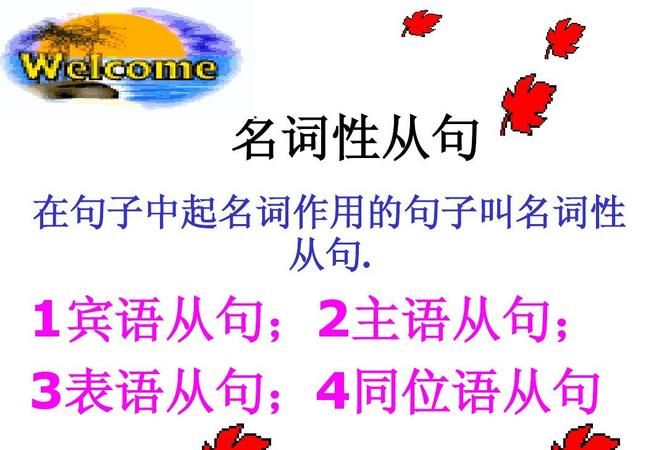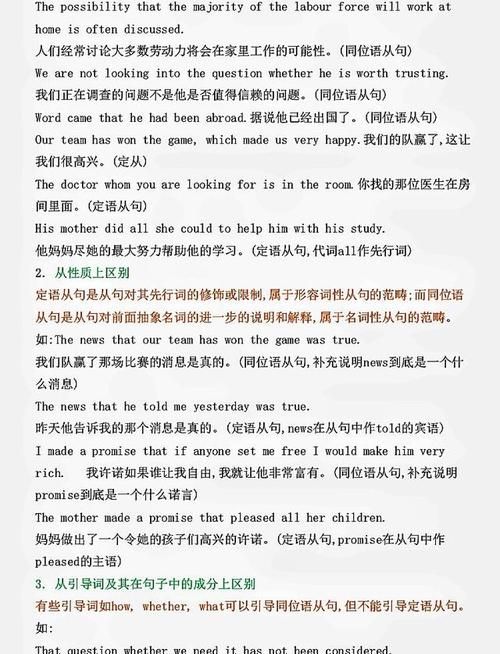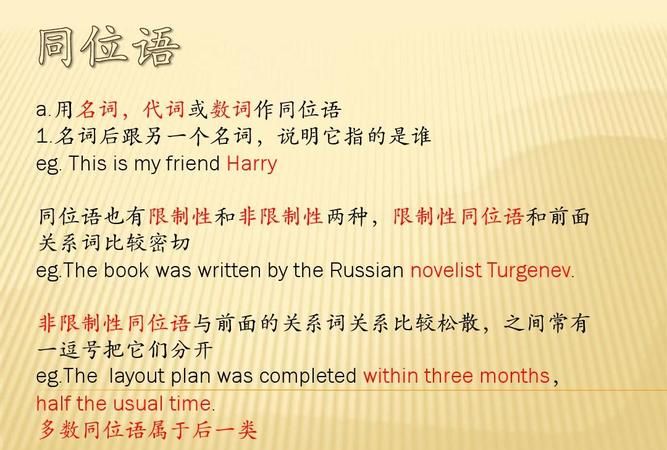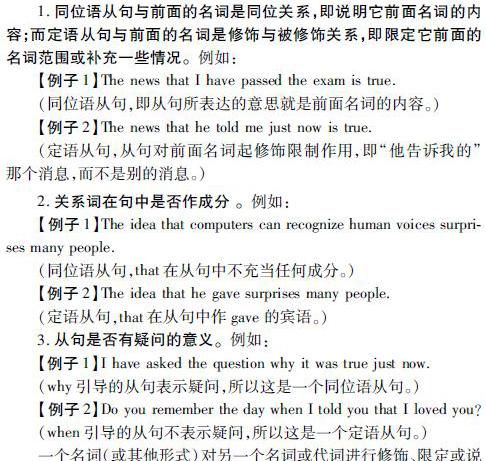本文目录
同位语是什么可以举几个例子
“同位语”是用来进一步说明前面某一个名词的词.例如:
Mrs.Brown,John's mother is a kind lady.约翰的妈妈,布朗太太是一个和蔼的女士.
说明:这里的John's mother就是“同位语”,用来进一步说明Mrs.Brown的身份.
除了“名词”作同位语,还有用一个句子作同位语,我们叫它“同位语从句”.例如:
Word came that her husband was killed in an accident.有消息传来她丈夫在事故中丧生了.
说明:这里的同位语为her husband was killed in an accident,目的是用来进一步说明word,即“消息”的具体内容.
如需要,我还可以给你更多的例句.

同位语从句例句
同位语从句例句(一): 1、She hasn't made the decision whether she should give up。 她还没决定她是否应当放下。
2、I have no idea what has happened to him。 我不明白他发生了什么事。
3、There was no doubt that he is honest man。 毫无疑问他是诚实的人。
4、You have no idea how worried I was。 你不明白我当时有多担忧。
5、I have no idea why he resigned。 我不明白他为何辞职。
6、I have no idea when he will be back。 我不明白他什么时候会回来。
同位语从句例句(二):
一、同位语从句的引导词
引导同位语从句的词语通常有连词that,whether,连接代词和连接副词等。
1。 由whether引导
There is some doubt whether he will e。 他是否会来还不必须。
Answer my question whether you are ing。 你回答我的问题:你来不来。
The question whether it is right or wrong depends on the result。 这个是对还是错要看结果。
We are not investigating the question whether he is trustworthy。 我们不是在调查他是否能够信任的问题。
【注意】whether 可引导同位语从句,但if不能引导同位语从句。
2。 由that引导
We heard the news that our team had won。 我们听到消息说我们队赢了。
They were worried over the fact that you were sick。 他们为你生病发愁。
The news that we are having a holiday tomorrow is not true。 明天放假的消息不实。
I’ve e to the conclusion that it was unwise to do that。 我得出结论这样做是不明智的。
The fact that the money has gone does not mean it was stolen。 那笔钱不见了这一事实并不意味着是被偷了。
He referred to Copernicus’ statement that the earth moves round the sun。 他提到了哥白尼关于地球绕太阳转的说法。
【注意1】在某些名词(如demand, wish, suggestion, resolution等)后面的同位语从句要用虚拟语气。如:
They were faced with the demand that this tax be abolished。 他们应对废除这个税的要求。
They expressed the wish that she accept the award。 他们表示期望她理解这笔奖金。
There was a suggestion that Brown should be dropped from the team。 有一项提议是布朗应当离队。
The suggestion that the new rule be adopted came from the chairman。 采纳新规则的提议是主席提出的。
I can understand their eagerness that you should be the main speaker。 我理解他们期望你作主要发言人的殷切心境。
【注意2】引导同位语从句的连词that通常不省略,但在非正式文体中也能够省去。如:
He gabbed his suitcase and gave the impression he was boarding the Tokyo plane。 他拿起了手提箱,给人的印象是他要登上飞往东京的飞机了。
3。 由连接副词引导
I have no idea when he will e back。 我不明白他什么时候回来。
It is a question how he did it。 那是一个他如何做的问题。
He had no idea why she left。 他不明白她为什么离开。
You have no idea how worried I was! 你不明白我多着急!
4。 由连接代词引导
Have you any idea what time it starts? 你明白什么时候开始吗?
From 1985-90 I was an instructor at the regional party headquarters。 After that I went back to work in a factory。 Then I had no idea what a casino was。 从1985年到1990年我是地方党部的教员。随后我回到一家工厂工作。当时我不明白赌场是什么样的地方。
二、关于分离同位语从句
有时同位语从句能够和同位的名词分开。如:
The story goes that he beats his wife。 传说他打老婆。
The news got about that he had won a car in the lottery。 消息传开说他中彩得了一辆汽车。
The rumour spread that a new school would be built here。 谣传那里要盖一所新学校。
Report has it that the Smiths are leaving town。 有传言说史密斯一家要离开这座城市。
The thought came to him that maybe the enemy had fled the city。 他想到可能敌人已逃离这座城市。
The order soon came that all citizens should evacuate the village。 不久命令下来,所有居民都必须撤出村子。(G31)
1.意义的不一样
同位语从句是用于说明所修饰名词的具体资料的,它与被修饰词语通常能够划等号;而定语从句是限制所修饰名词的,它的作用是将所修饰的名词与其他类似的东西区别开来:
We are glad at the news that he will e。 听到他要来这个消息我们很高兴。(news的资料就是that he will e,故that引导的是同位语从句)
We are glad at the news that he told us。 听到他告诉我们的这个消息我们很高兴。(that从句是限制the news的资料的,即我们高兴只是因为他告诉的这个news而不是其他的news,故that从句为定语从句)
2。 引导词的功能上的不一样
that引导同位语从句时,它不充当句子成分,而引导定语从句时,它作为关系代词,要么充当定语从句的主语,要么充当定语从句的宾语。如上例 that he told us中的that就充当told的宾语。
3。 引导词的不一样
what, how, if, whatever 等可引导名词性从句,但不引导定语从句。
4。 被修饰词语的区别
同位语从句所修饰的名词比较有限,通常有hope, wish, idea, news, fact, promise, opinion, suggestion, truth等,而定语从句所修饰的名词则十分广泛。 另外,when和where 引导定语从句时,通常只修饰表示时光和地点的名词,而它们引导同位语从句时却不必须;又如why引导定语从句,它通常只修饰名词the reason,而它引导同位语从句时则不必须:
We don’t understand the problem why this is the best choice。 我们不明白这个问题,为什么这是最好的选择。(同位语从句 )
The reason why he didn’t e to the meeting is that he is ill。 他未能来开会,原因是他生病了。(定语从句)
I have no idea when they will e 。 我不明白他们什么时候来。(同位语从句)
I’ll never forget the days when I lived there。。 我永远不会忘记我住在那儿的日子。(定语从句)

什么是同位语
同位语从句是指在复合句中跟在名词后面,充当名词的同位语的从句,它是对前面的名词起到解释和说明的作用。同位语从句常位于news,idea,fact,thought,problem,answer,belief,possibility,plan,suggestion,promise,teport,question,truth,proof,order,hope,information...等的名词后面。 同位语部分是个句子,就是同位语从句,这种用法比较"固定",把关键的几个词背下来. 下面这个材料供参考. =========================== 一、在复合句中用作同位语的从句叫同位语从句。它一般跟在某些名词后面,用以说明该名词表示的具体内容。如: I heard the news that our team had won.我听到了我们队获胜的消息。 I had no idea that you were here.我不知道你在这里。 二、可以跟同位语从句的名词通常有new,idea,fact,promise,question,doubt,thought,hope,message,suggestion,word(消息),possibility等。如: I’ve come from Mr wang with a message that he won’t be able to see you this afternoon. 我从王先生那里来,他让我告诉你他今天下午不能来看你了。 三、英语中引导同位语从句的词通有连词 that,whether,连接副词 how,when,where等。(注:if,which 不能引导同位语从句。)如: l have no idea When he will be back.我不知道他什么时候回来。 He must answer the question whether he agrees to if or not. 他必须回答他是否同意这样一个问题。 四、有时同位语从句可以不紧跟在说明的名词后面,而被别的词隔开。 如: Several years later,word came that Napoleon himself was coming to inspect them. 几年以后,有消息传来说拿破仑要亲自视 察他们。 The thought came to him that maybe the enemy had fled the city. 他突然想起可能敌人已经逃出城了。 五、同位语从句与定语从句的区别。 1、同位语从句与前面的名词是同位关系,即说明它前面名词的内容;而定语从句与前面的名词是修饰与被修饰关系,即限定它前面的名词范围,或补充一些情况。如: The news that l hove passed the exam is true.我通过了考试这一消息是真的。 (同位语从句,即从句所表达的意思就是前面名词的内容。) The news that he told me just now is true.他刚才告诉我的消息是真的。 (定语从句,从句对前面名词起修饰限制作用,即“他告诉我的”那个消息,而不是别的消息。) 2、引导同位语从句的that是连词,在从句中不充当任何成份,而引导定语从句的that是关系代词,除起连接作用外,还在从句中充当主语、宾语或表语等。如: The idea that computers can recognize human voices surprises many people. 计算机能够识别人的声音的想法使许多人感到惊奇。(that在从句中不充当任何成份。) The idea that he gave surprises many people.他提出的观点令许多人感到吃惊。 (that在从句中作gave的宾语。) 追问: 晕,又一个复制党

同位语从句例句
句子来做同位语的时候,叫同位从句。同位语从句是对于前面这个名词,尤其是抽象名词的一个解释,例句:The news that our football team won the match was not true. 这就是同位语从句。
扩展资料
同位语从句,这里我们先要理解它的更大的概念,那就是同位语。所谓同位语就是相同的位置。相同的位置,我对前面的名词来进行说明,来进行解释。比如说,中文当中的同位语,跟英语当中的同位语,简直是一模一样。毛泽东中国一代伟人,创立了新中国。那我们就会用中国一代伟人解释毛泽东。这就叫同位语。那么同位语可以用名词来做,也可以用句子来做。当用句子来做同位语的.时候,那自然就叫同位从句了。
我们先看一个中文当中的同位语从句。这个消息,中国球队赢了,不是真的。大家看,我的主干就是:这个消息不是真的。但是这个消息非常的抽象,到底是什么样的消息呢?我就需要用一个句子来描述一下这个消息。这个消息,中国球队赢了,不是真的。The news that our football team won the match was not true.那这里,整个的谓语部分,补语部分,我们的主干部分是The news was not true.
但是我们需要解释一下the news什么样的消息呢?The news that our football team won the match was not true. 这就是同位语从句。总结一下,我们首先要理解什么是同位语,然后再去理解一下什么是同位语从句。关于刚才这个例句我们一定要知道,同位语从句是对于前面这个名词,尤其是抽象名词的一个解释。

以上就是关于同位语句子举例子 ,同位语是什么可以举几个例子的全部内容,以及同位语句子举例子 的相关内容,希望能够帮到您。
